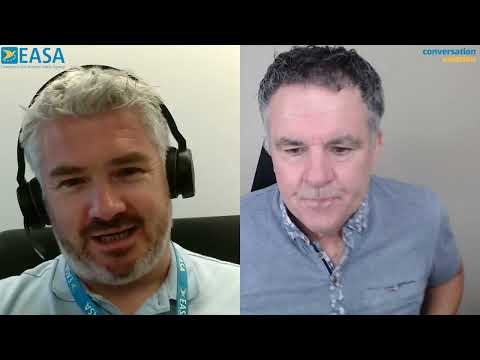SURPRISE: HOW NATIVE ENGLIGH SPEAKERS COMMUNICATE WITH ATC IS A PROBLEM


EASA’s Director of Safety Promotion has an incredibly informative conversation with an academic on COMMUNICATION and the requirement of English proficiency. It is quite possible that more than a few readers will soon click off because they assume that the problem identified is the poor diction of non-native English/ English-as-second-language speakers are at fault. “I already knew how they (international pilots and/or air traffic controllers from different nations) mess up basic information transfer!!!

Data and a scientific survey points to another culprit—NATIVE SPEAKERS. WHY? The analytics point to
- the speed with which English speakers talk,
- their tendency to use long sentences,
- verbalization with non-standard terminology,
- indistinct articulation words,
- failure to be aware of use of idiomatic expressions,
- speaking in dialects and accents that may confuse their audience and insensitivity about the recipient’s needs.
There are few things as mundane as speaking; it is a tool that each of us uses so much that it becomes routine, almost subconscious. Most dialogues occur face-to-face. Tone of voice, facial expressions, hand gestures and familiarity between those talking all add to comprehension. It is so commonplace that it is not a frequent subject for thought.
The founder of Mayflower College suggests that this skill merits more careful thought and consideration in the context of cockpit and tower/center transmission of SAFETY INFORMATION. He and Mr. Franklin posit some easy enhancements to speech patterns that will increase the likelihood that communication takes place (see George Bernard Shaw’s quote at the end of this post).
This review notes that the radio rate between Air Traffic and aircraft involves a high level of syllables per second. Anyone who has listened to a frequency between a JFK departure FPL during the 9am peak time, must acknowledge that the only other places that they observe such rapidity is at an auction or on those obnoxious TV ads reciting RX warranties. These Fast Talkers may need some additional guidance to be sure that their messages are received.

Aviation Language – A Shared Responsibility

Airport and Ground Handling ATM Flight Operations

26 September 2023
In aviation, English language problems are a significant risk to safety. An ICAO review of 28,000 incident/accident reports found that communication was a factor in over 70% of the occurrences.

In this article by Paul Stevens, from Mayflower College we look at the shared responsibilities that go with communicating in an aviation context. Check out also the videocast/ podcast recording below. Also available on the Together4Safety YouTube Channel and the Conversation Aviation podcast.
The ICAO language proficiency requirements
In 2008, ICAO introduced the Language Proficiency Requirements to improve aviation safety. They aim to ensure that all pilots and controllers working in an international environment are able to communicate clearly in English. These English language requirements apply to all personnel – including native English speakers, which sometimes surprises people.

Much of the burden of language proficiency has fallen on people for English as a Second Language (ESL) speakers. They have had to invest considerable time, money and effort into improving and maintaining their level of English. They have been required to pass Aviation English exams in order to retain their right to work, with the majority having to be re-tested every 3-5 years.
Something for native speakers as well
Native-English speakers, by and large, have been unaffected. But ICAO did not intend this to be the case. The Manual on the Implementation of ICAO Language Proficiency Requirements states:
“…native and other expert users of English can acquire strategies to improve cross-cultural communications…”.
Native speakers in particular have “an ethical obligation to increase their linguistic awareness” and “…focus on strategies that aid comprehension and clarity”.
There are good reasons for ICAO to suggest that native-English speakers should take their share of the responsibility. The comfortable assumption made by many native-English speakers is: “English is my first language therefore I speak it perfectly; if you don’t understand me, it’s not my problem.”
So, ESL speakers continue to improve their language skills to improve safety. Unfortunately, the same cannot always be said for native English speakers. Leaving aside questions of ethics and fairness, how well is this working? Are native English speakers really a problem? The straightforward answer is – YES!
Here are some comments from different operational staff.
“I see these communications breakdowns at work every day,” Maria, Spanish controller “I think every non-native English speaker has had difficulty communicating with native English speakers,” Vasil, Bulgarian controller “I have experienced these problems many, many times in my aviation career,” Stefano, Italian pilot
“I understand non-native speakers more than the native ones because the non-native speakers speak slowly and make short sentences,” Andres, Colombian Pilot
In 2022, Mayflower College in the UK asked 1,974 pilots and controllers from 112 countries:
- “Do you think that aviation safety is ever compromised because of the way native speakers use English?” 65% said YES.
- “Would it be useful to provide TRAINING to help native English-speaking pilots and controllers communicate more effectively, especially with non-native English speakers?” 89% said YES.
The main things that native English speakers could focus on are as follows:
1) Using standard phraseology
Standard Phraseology is intended to simplify communication through the use of a controlled vocabulary and grammar which all aviators are trained to understand. To achieve effective communication in international aviation, the Americans, British, Australians, etc. need to restrict themselves to standard phraseology whenever possible.
When non-routine situations arise which are not covered by standard phraseology, ‘plain English’ is required. In this case, native English speakers need to learn how to use plain English appropriately, using words and phrases which are likely to be understood by members of the international aviation community. An article follows on this topic next in the magazine.
2) Speak more slowly
The Mayflower College results are corroborated by other studies. In one study, fast speech by air traffic controllers was shown to be the cause of communication breakdown in 28% of misunderstood call signs and 42% of misunderstood level changes.
So, how fast do native speakers speak?
ICAO explicitly recommends speaking at 100 words per minute, which is approximately equal to 4.1 syllables per second (sps).
However, studies show that American air traffic controllers speak on average at a rate of 6.1 syllables per second (sps).
Compare that to the speech rate in American movies where the average is 5.1 sps and to American news programs where the average is 4.7 sps.

Another study shows that when speech is delivered at the typical rate of an American air traffic controller (6.1 sps), non-native speakers cannot recognise 20% of the words.
In other words, IT SEEMS THAT NATIVE ENGLISH-SPEAKING AVIATORS MAY BE SPEAKING 50% FASTER THAN ICAO RECOMMENDS.
To make matters worse, they are of course mainly speaking over the radio, where international pilots and controllers have no non-verbal cues to help the communicative process.
3) Unclear Speech – Try not to speak with a strong accent/pronunciation.
According to ICAO, aviation personnel (including native English speakers) must ‘use a dialect or accent which is intelligible to the aeronautical community’. It is incorrect to assume that because English is your first language, your pronunciation is automatically intelligible to everyone.
There is evidence that even native-English-speaking personnel cannot understand each other if they are from different countries, because their accents are unfamiliar and difficult to comprehend. This is even more of a burden for ESL speakers.

4) Have more patience
Safety is a shared responsibility; and a vital component is empathy, the ability (or at least the willingness to try) to understand what the other person is experiencing.
Unfortunately, it seems that many native English speakers lack empathy for the challenges faced by non-native English speakers.
Why is this?
- They haven’t been trained adequately – the assumption is that “English is our language so we must be good enough”.
- They may not be aware of the problem. “I’ve been doing this work for 20 years and never had any complaints”. But except after the most drastic of situations, there is no routine feedback loop for foreign aviators to explain that native-English speech is problematic.
- Native-speakers have a poor record of learning foreign languages and as a result can find it difficult to put themselves ‘in the shoes’ of someone working in another language.
- The native-speakers educational systems probably rewarded the use of “clever, sophisticated” language. In aviation R/T however, simple and clear are much better than idiomatic and nuanced.
Effect of communicating under high cognitive load
All these communication problems are compounded by cognitive load – the amount of information the brain has to deal with at a particular time. The greater the cognitive load, the harder it is for the brain to process language effectively. This applies to native speakers as well as those who speak English as their second language. Language proficiency is not the main issue here – this is about the way that human brains work.

In radiotelephony, the most critical information is generally given during the most demanding phases of flight (take-off, level changes, final approach, landing). It is precisely at these stages that clear communication is most important – the brain has little “spare capacity” for language processing.
In conditions of high workload, the brain processes verbal information differently than the way it does during conditions of low workload. This makes mistakes more likely and is compounded if native speakers do not speak clearly and deviate from standard phraseology.
The well-known advice: “Aviate – Navigate – Communicate” breaks down when there is high workload. “Communicate” is supposed to be the final stage of a particular flight task but in reality, has to be done at the same time as the other 2 parts of the maxim, increasing cognitive load.
What can be done?
Experience shows us that native English speakers will not VOLUNTEER for training to show them how to improve their English skills when communicating with non-native speakers. In fact, many will resist the need for the training altogether, believing the sole responsibility lies with ESL speakers to improve their English. This is to miss the point.
For change to happen ICAO, national regulators, airlines, ATS providers and manufacturers will need to make training mandatory. Native English speakers have a vital role to play in ensuring safe, effective communication takes place.
“The single biggest problem in communication is the illusion that it has taken place”, George Bernard Shaw

Very good story. Although I am not involved in this area, I have read or seen accounts where collisions have resulted from such breakdowns. Not a good thing.
I note that whenever there is a discussion of communicating with foreign pilots my former colleagues at JFK are usually mentioned even though it is clear that they speak accent free, King’s English (Kings County that is). I don’t deny that there is a problem, but I would suggest that slowing delivery in ALL cases is probably not possible. By the way, I claim a very, very small contribution to the establishment of English as the “standard” language (if that’s the right term) by forwarding an NTSB recommendation on the subject to the Secretariat. Twenty plus years ago the US did not use ICAO recommended phraseology in all cases. At the time there was an informal working group with FAA and European participants to try to come to some sort of agreement. Last I knew of the result there really wasn’t much progress. I think they agreed to say “Taxi into position and wait” instead of “taxi into position and hold”. Hopefully more progress has been made in the interim.
The problem is real–https://onemileatatime.com/news/sfo-atc-loses-patience-qatar-airways-pilot/ #Timothy L. Arel should consider getting the training mentioned in this article. Yes, the SFO incident was largely pilot driven but some training might add to safety margins #FAANews.